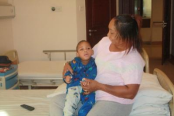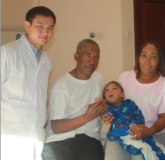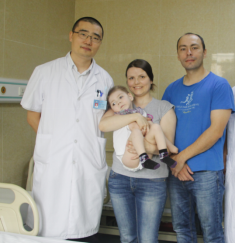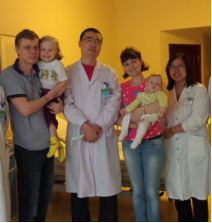Case: Jayden
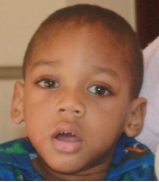
Background
The infant was delivered full-term via uncomplicated vaginal birth, with no history of perinatal asphyxia or hypoxia. At five days old, he was diagnosed with neonatal jaundice (serum bilirubin: 39 μmol/L), despite no family history of genetic disorders. Following a blood transfusion, he unexpectedly developed a coma of unknown etiology and required nutritional support. After 5-6 days, he spontaneously regained consciousness but exhibited no responsiveness to auditory or visual stimuli.
At two months of age, the infant presented with persistent feeding difficulties, leading to a diagnosis of pyloric stenosis (a gastric outflow obstruction) at a local hospital. He underwent pyloromyotomy (corrective surgery), after which feeding improved marginally, though intake remained restricted to pureed and semi-liquid foods. Rehabilitation therapy was initiated but later discontinued and has not been resumed to date.
Pre-Treatment Condition (Before the First Course of Treatment)
1. Speech & Language: utters simple words/phrases; demonstrates severely impaired receptive language skills.
2. Upper Limb Function: persistent bilateral hand fisting; fixed elbow flexion contractures.
3. Gross Motor Skills: unable to achieve independent sitting, standing, or ambulation
4. Neuromuscular Status: hypertonia in lower extremities
5. Gait Abnormalities: scissoring gait and bilateral toe-walking, requiring parental support for ambulation.
6. Nutritional Status: persistently reduced oral intake/appetite.
Pre-Treatment Condition (Before the First Course of Treatment)
1. Speech & Language: utters simple words/phrases; demonstrates severely impaired receptive language skills.
2. Upper Limb Function: persistent bilateral hand fisting; fixed elbow flexion contractures.
3. Gross Motor Skills: unable to achieve independent sitting, standing, or ambulation
4. Neuromuscular Status: hypertonia in lower extremities
5. Gait Abnormalities: scissoring gait and bilateral toe-walking, requiring parental support for ambulation.
6. Nutritional Status: persistently reduced oral intake/appetite.

Outcomes After the First Course of Treatment
Second Course of Stem Cell Treatment (Nov 2014)
Outcomes After the Second Course of Treatment
1. Speech & Language Development: can produces complex phrases; measurable improvement in comprehension.
2. Upper Limb Function: achieves full hand extension; reduction in elbow flexor hypertonia.
3. Gross Motor Milestones: independent sitting for 10 minutes; independent standing for 3 minutes.
4. Gait & Lower Limb Function: consistent heel strike pattern during assisted ambulation; marked reduction in scissoring.
